Id1 is a common downstream target of oncogenic tyrosine kinases in leukemic cells
- PMID: 18559972
- PMCID: PMC2518899
- DOI: 10.1182/blood-2007-07-103010
Id1 is a common downstream target of oncogenic tyrosine kinases in leukemic cells
Abstract
Oncogenic tyrosine kinases, such as BCR-ABL, TEL-ABL, TEL-PDGFbetaR, and FLT3-ITD, play a major role in the development of hematopoietic malignancy. They activate many of the same signal transduction pathways. To identify the critical target genes required for transformation in hematopoietic cells, we used a comparative gene expression strategy in which selective small molecules were applied to 32Dcl3 cells that had been transformed to factor-independent growth by these respective oncogenic alleles. We identified inhibitor of DNA binding 1 (Id1), a gene involved in development, cell cycle, and tumorigenesis, as a common target of these oncogenic kinases. These findings were prospectively confirmed in cell lines and primary bone marrow cells engineered to express the respective tyrosine kinase alleles and were also confirmed in vivo in murine models of disease. Moreover, human AML cell lines Molm-14 and K562, which express the FLT3-ITD and BCR-ABL tyrosine kinases, respectively, showed high levels of Id1 expression. Antisense and siRNA based knockdown of Id1-inhibited growth of these cells associated with increased p27(Kip1) expression and increased sensitivity to Trail-induced apoptosis. These findings indicate that Id1 is an important target of constitutively activated tyrosine kinases and may be a therapeutic target for leukemias associated with oncogenic tyrosine kinases.
Figures
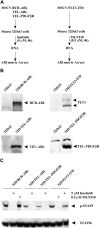

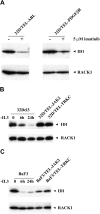
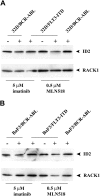
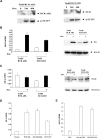
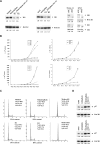

Similar articles
-
Mutated tyrosine kinases as therapeutic targets in myeloid leukemias.Adv Exp Med Biol. 2003;532:121-40. doi: 10.1007/978-1-4615-0081-0_11. Adv Exp Med Biol. 2003. PMID: 12908554 Review.
-
ARG tyrosine kinase activity is inhibited by STI571.Blood. 2001 Apr 15;97(8):2440-8. doi: 10.1182/blood.v97.8.2440. Blood. 2001. PMID: 11290609
-
Targeting PIM kinases impairs survival of hematopoietic cells transformed by kinase inhibitor-sensitive and kinase inhibitor-resistant forms of Fms-like tyrosine kinase 3 and BCR/ABL.Cancer Res. 2006 Apr 1;66(7):3828-35. doi: 10.1158/0008-5472.CAN-05-2309. Cancer Res. 2006. PMID: 16585210
-
Pharmacologic mitogen-activated protein/extracellular signal-regulated kinase kinase/mitogen-activated protein kinase inhibitors interact synergistically with STI571 to induce apoptosis in Bcr/Abl-expressing human leukemia cells.Cancer Res. 2002 Jan 1;62(1):188-99. Cancer Res. 2002. PMID: 11782377
-
Proteomics approaches to elucidate oncogenic tyrosine kinase signaling in myeloid malignancies.Curr Pharm Biotechnol. 2006 Jun;7(3):185-98. doi: 10.2174/138920106777549696. Curr Pharm Biotechnol. 2006. PMID: 16789903 Review.
Cited by
-
Regulation of AKT signaling by Id1 controls t(8;21) leukemia initiation and progression.Blood. 2015 Jul 30;126(5):640-50. doi: 10.1182/blood-2015-03-635532. Epub 2015 Jun 17. Blood. 2015. PMID: 26084673 Free PMC article.
-
Prognostic implications of the ID1 expression in acute myeloid leukemia patients treated in a resource-constrained setting.Hematol Transfus Cell Ther. 2024 Jul-Sep;46(3):250-255. doi: 10.1016/j.htct.2023.04.005. Epub 2023 Jun 19. Hematol Transfus Cell Ther. 2024. PMID: 37393163 Free PMC article.
-
The Id-protein family in developmental and cancer-associated pathways.Cell Commun Signal. 2017 Jan 25;15(1):7. doi: 10.1186/s12964-016-0161-y. Cell Commun Signal. 2017. PMID: 28122577 Free PMC article. Review.
-
An ShRNA Screen Identifies MEIS1 as a Driver of Malignant Peripheral Nerve Sheath Tumors.EBioMedicine. 2016 Jul;9:110-119. doi: 10.1016/j.ebiom.2016.06.007. Epub 2016 Jun 4. EBioMedicine. 2016. PMID: 27333032 Free PMC article.
-
Inhibitor of DNA binding 2 (ID2) regulates the expression of developmental genes and tumorigenesis in ewing sarcoma.Oncogene. 2022 May;41(20):2873-2884. doi: 10.1038/s41388-022-02310-0. Epub 2022 Apr 14. Oncogene. 2022. PMID: 35422476 Free PMC article.
References
-
- Daley GQ, Van Etten RA, Baltimore D. Induction of chronic myelogenous leukemia in mice by the P210bcr/abl gene of the Philadelphia chromosome. Science. 1990;247:824–830. - PubMed
-
- Van Etten RA, Jackson P, Baltimore D. The mouse type IV c-abl gene product is a nuclear protein, and activation of transforming ability is associated with cytoplasmic localization. Cell. 1989;58:669–678. - PubMed
-
- Okuda K, Golub TR, Gilliland DG, Griffin JD. p210BCR/ABL, p190BCR/ABL, and TEL/ABL activate similar signal transduction pathways in hematopoietic cell lines. Oncogene. 1996;13:1147–1152. - PubMed
MeSH terms
Substances
Grants and funding
LinkOut - more resources
Full Text Sources
Medical
Molecular Biology Databases
Miscellaneous

